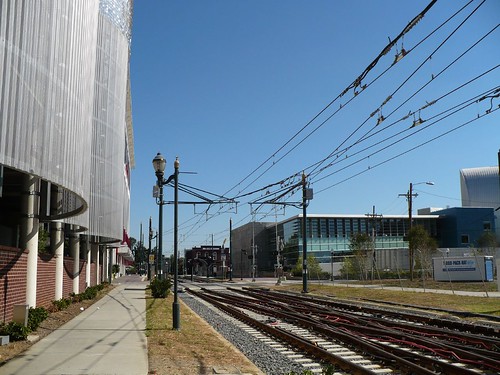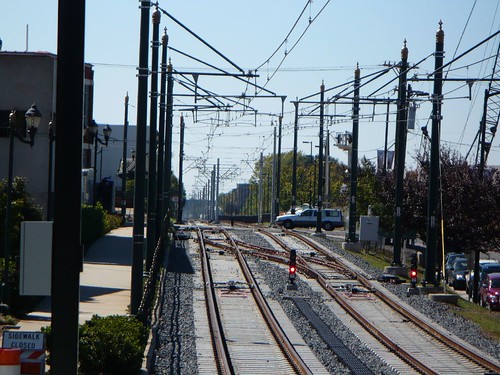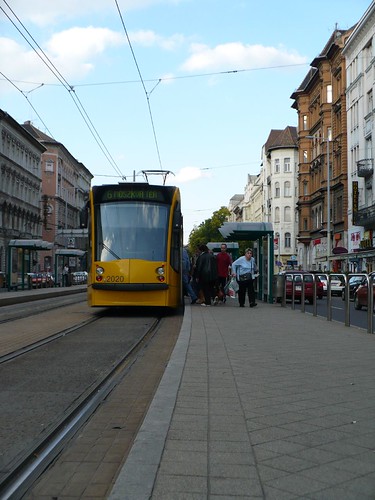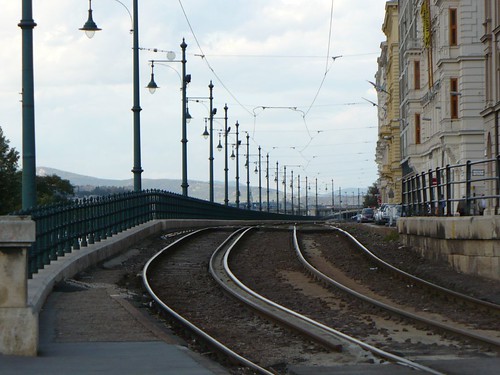Some versions can be pretty ugly such as New Jersey Transit's catenary:
 Photo Courtesy HeritageTrolley.org
Photo Courtesy HeritageTrolley.orgHere's a crossover in Charlotte and a long straight stretch.


Unfortunately this is sometimes the ugly that people think about when they think about overhead wires. While it's music to my lungs, many other people don't feel the same way.
The catenary differs from a simple trolley wire suspension in that there are more wires as well as generally more visual obstruction. The catenary is used for higher speed lines because the tension created in the wire is great enough to keep the pantograph from bouncing up against the wire which can cause great damage. Ultimately trolleywire is perfectly good for streetcars in cities and I would generally believe that it's probably the first consideration of designers of modern streetcar systems.
Below is a Combino Supra under trolley wire.

More Budapest

Some fun images from 1924's Electric Railway Handbook



18 comments:
Very helpful. Thank you.
mmm thanks for this. I could've also just gone to the Wikipedia page on overhead lines: http://en.wikipedia.org/wiki/Overhead_lines#Overhead_catenary
Though, your comparison is better for the purpose of delineating the difference between the two, whereas the article is primarily about catenary wire and merely alludes to the differences. Perhaps some edits to the article based on and referencing your post are in order...
True, N. J. Transit catenary can be a little "overdone" in spots. But in many places, such as Newark Light Rail, it's very tastefully done. In that case, it consists of a single line of poles between the two tracks. And where street running is involved, simple {single} trolley wire is used. It's supported by fancy, good looking poles. This can be found in Newark and Jersey City.
Also, in further defense of NJT, the heavy rail commuter lines inherited from the Lackawanna RR has a very elegant catenary system.
The catenary system on the Newark City Subway is also inadequate: it's not constant tension, so that hot weather means speed restrictions. As for the historic catenary, the first style of New Haven catenary has finally disappeared a few years ago when they redid the Port Chester to Stamford stretch, the second style is on its way out with the re-wiring of the Stamford-Norwalk stretch, and the eventual goal is to replace everything with modern constant-tension stuff. The PRR style catenary is still in use on most of Amtrak, but there has been some effort to replace it with constant tension here and there. They're probably going to start looking more seriously at replacing it soon, as it's already almost 80 years old in places, and will need replacing before it starts falling apart completely. A nice side effect might be Acela speeds above 135 between New York and Washington.
With the more or less slow speed of the City Subway {now called Newark Light Rail}, I doubt constant tensioned catenary is really necessary.
TransitJeff, try riding it some time when all the 50/55 mph limits have been dropped to 25. Believe it or not, the Newark Subway is actually faster than the New York Subway, and that kind of slowdown makes a huge difference.
Arcady, but how many times does that really happen? I assume it only happens during periods of extremely hot weather. Does that justify the huge expense of installing constant tension catenary? However, you've brought up a good point and I will look into it.
Back when we had PCC cars with trolley poles operating on the City Subway line, I don't ever remember significant weather related trolley wire problems.
I fetishize catenary wire.
TransitJeff, is the incremental expense of constant tension really that much more than the expense of fixed catenary? My intuition is that it's not, you just have the weights/pulleys and a little bit of extra wire at the overlaps. The point is that they replaced all the overhead anyway (which was the huge expense), they may as well have done it right.
Don't forget Houston. The only catenary is on about a mile of private right of way. The rest of the line looks like this.
Apparently the small-radius turns on the Newark City Subway made constant tension catenary too difficult to install.
http://world.nycsubway.org/us/newark/
Note that in the Houston example, every second cross-span has a feeder wire running along it! I guess you need that for what amounts to the equivalent of four old-style streetcars, plus the air conditioners.
As for Newark, are there really that many more small-radius curves than on the HBLR? I'll have to go take a closer look at both systems when I'm in the area and see for myself what sorts of solutions they adopted.
Since the original part of the NLR (the City Subway) was originally built for small wooden trolleys, the tight radius argument sounds plausible.
The loops at Penn Station are pretty tight, I don't think they are so tight anywhere else.
The original Newark City Subway alignment was in fact built for canal boats!
Yes, the original Newark light rail roadbed was the Morris Canal. It didn't become a trolley line until the mid-1930's. They never used "small" cars on the line. Public Service always used quite large, double truck cars {I have lots of photos}. The tightest radius loop was at Franklin Ave., at the Belleville border. That loop has since been removed and the station was renamed Branch Brook Park. Don't forget, there is also a very tight radius loop at our Bloomfield shop facility. I've actually been around it on a "three car train" and have photos of the event.
The "two" loops at Penn Station are tight, but the articulated light rail cars use both of them. I will look into why we don't have constant tension catenary on the Newark Light Rail line. Stay tuned.
IIRC, the Franklin Ave loop was added when City Subway switched from the aging trolley fleet to the PCC cars (for those not familiar with them, PCC's only have controls at one end)
And I was wrong about the small trolley cars as you pointed out. I was thinking of the Morris County Traction trolleys, which only went to the Public Service Terminal, not Penn.
Watching the new LRV's taking the loops at Penn is intersting. I use the new line to Broad Street Station pretty often. Anyone who's never used it should check it out when you're in the area.
Coincidentally, I was touring another section of the Morris Canal (at Waterloo Village) this afternoon.
This website is like a window to the world of electrified rail, from the novice to those involved in large electrification projects.
If I may suggest to add some interactive examples of common engineering challenges that arise during such projects and other simple examples how the electrification process works, from the power station until the OCS and return loop. Don't forget to add ELF measurements along the way!
Keep going good!
Post a Comment